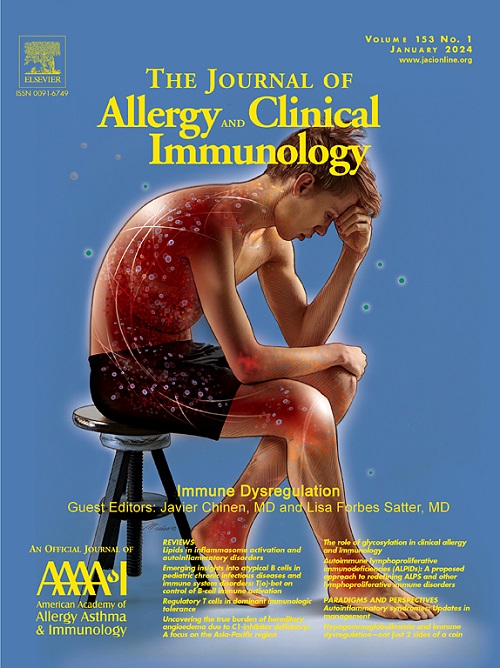LRBA functional deficiency caused by biallelic LRBA missense variants characterized by Evans syndrome or colitis.
IF 11.4
1区 医学
Q1 ALLERGY
引用次数: 0
Abstract
BACKGROUND Biallelic loss-of-function (LOF) mutations in LRBA (lipopolysaccharide-responsive and beige-like anchor) lead to a severe syndrome of early-onset immune dysregulation called LRBA deficiency. Monoallelic CTLA4 mutations lead to a similar phenotype. In both conditions, Treg CTLA-4 levels are significantly decreased. In previously reported cases of symptomatic disease associated with LRBA pathogenic variants, patients usually have severely decreased or absent LRBA protein levels. OBJECTIVE We describe here five patients with biallelic missense variants in the LRBA gene presenting predominantly with Evans syndrome or colitis. METHODS LRBA and CTLA-4 levels were investigated in LRBA missense, "classic" LRBA, and CTLA-4 insufficiency samples. RESULTS Surprisingly, all five LRBA missense patients have normal expression of LRBA protein. However, CTLA-4 intracellular expression was reduced to similar levels as those seen in CTLA-4 insufficiency patients at resting state. Lower levels of surface CTLA-4 are seen upon cell activation, indicating that these LRBA variants lead to reduced CTLA-4 cell surface expression. Several of the missense variants are shared between unrelated patients in the cohort suggesting a mutational hotspot or founder effect for those with shared ancestry. CONCLUSION Herein, we describe novel LRBA deficiency variants resulting in quantitative or qualitative LRBA defects, leading to reduced intracellular resting levels and induced surface levels of CTLA-4.以Evans综合征或结肠炎为特征的双等位LRBA错义变异引起的LRBA功能缺陷。
背景LRBA(脂多糖反应性和米色样锚)的双偶功能缺失(LOF)突变会导致严重的早发型免疫失调综合征,称为LRBA缺乏症。单倍CTLA4突变也会导致类似的表型。在这两种情况下,Treg CTLA-4 水平都会显著下降。在以前报道的与 LRBA 致病变异相关的无症状疾病病例中,患者的 LRBA 蛋白水平通常严重下降或消失。结果令人惊讶的是,所有五例 LRBA 错义患者的 LRBA 蛋白表达均正常。然而,CTLA-4 细胞内表达降低到了与 CTLA-4 功能不全患者在静息状态下相似的水平。细胞活化时,表面 CTLA-4 水平降低,这表明这些 LRBA 变异导致 CTLA-4 细胞表面表达减少。结论在本文中,我们描述了导致LRBA定量或定性缺陷的新型LRBA缺陷变异,这些变异导致细胞内静息水平和诱导的CTLA-4表面水平降低。
本文章由计算机程序翻译,如有差异,请以英文原文为准。
求助全文
约1分钟内获得全文
求助全文
来源期刊
CiteScore
25.90
自引率
7.70%
发文量
1302
审稿时长
38 days
期刊介绍:
The Journal of Allergy and Clinical Immunology is a prestigious publication that features groundbreaking research in the fields of Allergy, Asthma, and Immunology. This influential journal publishes high-impact research papers that explore various topics, including asthma, food allergy, allergic rhinitis, atopic dermatitis, primary immune deficiencies, occupational and environmental allergy, and other allergic and immunologic diseases. The articles not only report on clinical trials and mechanistic studies but also provide insights into novel therapies, underlying mechanisms, and important discoveries that contribute to our understanding of these diseases. By sharing this valuable information, the journal aims to enhance the diagnosis and management of patients in the future.

 求助内容:
求助内容: 应助结果提醒方式:
应助结果提醒方式:


